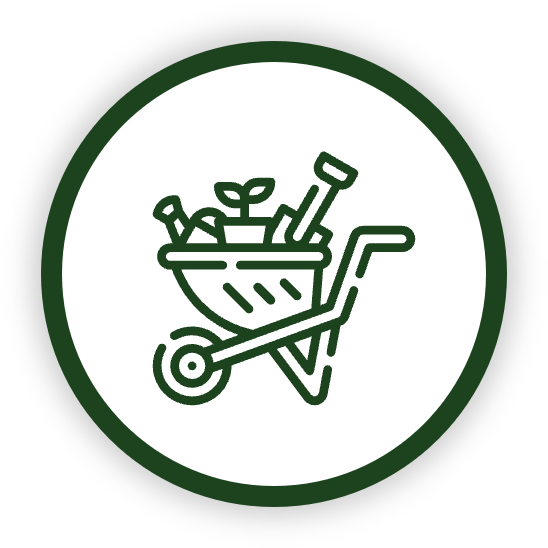2024 Q3 Impact Report
Letter from Founder and Team
Summertime sizzled in Oklahoma. Quarter three in North Central Oklahoma was challenging for agriculture, with extreme heat and dry spells limiting crop yields, water availability and resources for wildlife.
July, characterized by extreme heat, with temperatures frequently surpassing 100°F with very little rainfall. Conditions persisted into August putting a strain on Milo and Sunflower crops that were planted in the second quarter. Despite our best efforts, the drought posed significant stress, and as a result the crop self-terminated. Wildlife then foraged on the 4–6-inch green plants in the late summer months.
In August, we focused on soil health, natural weed suppression, and infrastructure. Farm management preformed a prescribed burn on the northwest and southwest fields. By intentionally burning specific areas, it reduces invasive species, recycles nutrients back into the soil in turn enhancing field quality. Next, terrace work began in the Northwest field near the Tiny House. Terracing involves creating stepped levels on a sloped field to reduce soil erosion and manage water runoff more effectively. By slowing down water flow, terraces allow water to infiltrate the soil, improving moisture retention for crops. Additionally, terracing can help mitigate the efforts of droughts by maintaining soil health and preventing nutrient loss.
This quarter further investment was made in infrastructure, specifically farm equipment. A new addition to the farm is a Zero-turn Lawn Mower known as “Mojo Rising”. Our intensions are to use “Mojo Rising” in the orchard and around boarder trees. Zero-turn mowers allow the operator to manicure land with more detail and operate more efficiently. Other additions include a pull-behind hay swather. This implement will allow us to cut and harvest our own hay to market. And finally, a larger utility trailer. We found the one we previously had just wasn’t big enough for most farm jobs and needed an upgrade!



In other efforts to alleviate drought stress, irrigation bags were installed in the orchard and boarder trees. Routine watering was scheduled and maintained throughout the third quarter.
Though conditions have been harsh, the honeybees have continued their efforts here at Rainmaker. A later September report recorded the hive had produced 30 pounds of honey! Plans to continue supplemental feeding are in place leading into quarter four.
Our projects are working to do good on multiple fronts: carbon sequestration, regenerating soil, make food for those in need, plant diverse crops for stability in changing times, and providing habitat to support our farm as part of the larger matrix of natural systems in the region
We could not do our work without donors. Our foundation’s administrative costs are covered through sponsorship donations, and all other donations go directly to on the ground project actions.
Summary of Q3 Activities
Our donor-funded activities are broken down into 7 main categories. The activities completed during this quarter are outlined below:

University Involvement Support/ Science Projects
- Ongoing conversations with Oklahoma State University about participating in additional research projects, speaking events with students, and other opportunities for engagement.

Diverse Planting
- Perennial:
-
- We continue to care for the orchard trees.
- Irrigation bags were installed on the orchard and boarder trees for efficient watering for the remainder of the season.
-
- Annual:
- Sunflowers: did not germinate.
- Milo: grew to 4-6-inches in the northeast field. Little rainfall and excessive heat terminated the crop. Mile remained in the field and served as a forage for wildlife.
- Wheat: fields will continue to be prepared for the upcoming planting season in quarter four.

Livestock Incorporation
- Indirect Cattle and Chickens: No composted manure was spread this quarter. Application anticipated in quarter four pre or post plant.
- Direct Cattle: In this quarter 10 steers were added to the grass pasture – bringing a total of 21 head total. European Honeybees: Supplemental feeding has remained in place for our bees. Our bees have 30 pounds of honey in their hive, as of late September. Supplement will increase as fall and winter approach.

Cover Cropping
- Cover cropping is beneficial to regenerative farming in many ways. It protects the soil from erosion. Many species replenish essential nutrients, such as nitrogen, in the soil.
- Native grasses: The deep roots from native species also help sequester carbon. Our native grass cover crop around the orchard will continue to develop around the orchard, which will help with carbon sequestration and retaining water in that soil. The native grass, though its establishment was limited, still remains. There are some bunchgrasses in that region, but they are not the dominant species of cover.

Farm Equipment & Supplies
- New additions to the farm in Q3. Larger utility trailer, pull behind hay swather, and zero-turn lawn mower. Each we believe are good additions to the farm.

Infrastructure
-
Replanted boarder trees have established well and look to go into dormancy strong and ready for spring.
-
We continued to develop a water catchment system. The water tank was completed in August. Looking to continue construction plans with contractors.

Rainmaker Farm
- Ongoing monitoring of the Barn Owl Nest boxes Rainmaker Farm is using ecological pest management. There is no nesting evident yet, but there are signs of use (white wash etc.)
- We have been implementing a variety of Integrated Pest Management tools to manage the weedy or invasive species in our crops. Invasive weed management:
- A prescribed burn was implemented as a form of pest management. Northwest and southwest fields were mowed. Prescribed burns are carefully planned and controlled fire in a way to manage the land and improve soil health. The concentrated plant matter was burned in its mowed rows – terminating the viable seed.
Targets and Goal Tracking
We are on track to meet our targets and goals.
Next Steps
In Q4 2024 we anticipate the following:
-
- Invasive plant management is going to continue to be a priority leading into 2025.
- Mow field in preparation for fall planting.
- Continue efforts with weather station.
- Continue to develop water catchment system.
- Install orchard irrigation system.
- Potential honey harvest.
- Finalize fall planting plan.
- Plant cool season crops.
- Spread compost manure pre or post plant.
- Continue our outreach and education efforts.
- Clean and winterize equipment.
